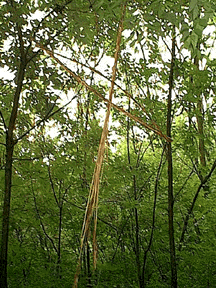
In an effort to introduce the residents of the greater Chicago metro area to the beautiful and important work currently being done in the field of environmental art, The Chicago Athenaeum @ Schaumburg introduces an exhibition and symposium, EARTH WORKS, devoted to the artworks of artists who demonstrate sensitivity to or celebrate the ecological health of the natural and civilized environment in their work in a variety of media. Some of the most prominent artists in Chicago and around the world are participating by contributing or constructing diverse art works at the Museum's International Sculpture Park and at the Museum from May 26, 2001 through September 9, 2001.
"EARTH WORKS" has two parts and locations.
Outdoor, site-specific installations, are installed at The Chicago Athenaeum's International Sculpture Park and feature projects by Illinois artists, Fred Bruney, Tor Faegre, Gosia Koscielak, and Sue Sommers. The artists will design and construct site-specific artworks that will celebrate the beauty of the park's natural features. The pieces are temporary and are removed after September 9, 2001.
The second part of "EARTH WORKS", located inside at The Chicago Athenaeum's museum building, features the work of Phillipe Barriere (architectural prototypes); Fred Bruney (site specific installation); Betsy Damon (photographs of her work in China); Mary Jane Duffy (paintings); Beverly Ellstrand (paintings), Tor Faegre (furniture made from found wood); Chris Garofolo (porcelain sculpture); Riccardo Santos Hernandez (painting); Deborah Kennedy (sculpture and documentation of installation) Gosia Koscielak (site specific installation); David Nash (documentation video of a site specific piece); Viviane Nunley (installation and painting); Rita Price (paintings); Sue Sommers (sculpture); John David Mooney (installation, symposium speaker); Caroline Ottmers (installation); and Leanne Woolery (installation and photographs).
TOR FAEGRE
CRANES IN THE SCULPTURE PARK-The birds in the trees of the Sculpture Park are made of a local reed, Phragmites. I hope they will serve as decoys to lure back the Sandhill Cranes that once upon a time thrived in this area.

Installation of reed cranes in the sculpture park by Tor Faegre
FOUND WOOD FURNITURE-I forage for pieces of the natural world and combine these with lumber and steel. I look for interesting shapes created through natural growth: The trees and I collaborate to produce a piece of furniture.
I like furniture that is light in weight, so light that it looks like it will float off. The idea for a FLOATING TABLE came when I saw a grove of cottonwoods springing up in an old field. I wanted to use the trees just as they grew. In this table I use peeled willow with pine for the top.
The FOLDING SCREENS are made of cottonwood, maple, willow, and dogwood. One has a single joyous figure in the middle. The other I call "The Argument". It has two figures confronting each other in a dispute.
SUE SOMMERS
At the International Sculpture Park I have five PRAIRIE PLANTS made from aluminum, which has been bent , sanded and colored. Knowing our native plants is like knowing our own names, bringing us into intimacy with our environment.
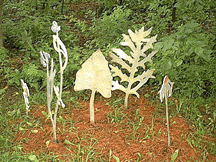
As a whole, the METAMORPHESIS SERIES of sixteen shrines reflects the cycle of life birth, growth, change, death the constant movement and dance of everything in the universe. Initially I did watercolor drawings of each stage of the Peacock butterfly and subsequently discovered the boxes that I used to house them. The boxes remind me of scientific drawers in which butterflies are kept. I also think of them as being individual and intimate places for contemplating a moment in the life cycle. Each piece has a word and a natural object, which poetically intuits a different instant in metamorphosis. The individual presentation is meant to enhance the meaning. While each shrine is a piece of its own, the series can also be connected in any number of combinations to emphasize the playfullness of life and the mysterieous process of change.
The SHRINES are an exploration of the sacred. In this investigation, I have made pieces that have to do with nature, a universally unifying and potentially awesome theme. PRAIRIE SHRINE uses images and materials (dirt, earth) that suggest the sacred nature of the great prairie that is our Illinois inheritance. CAGED FLIGHT and SACRED SPACE were both, in part, inspired by trips to India. Organic shapes, earth texture and mirrors that I saw there delighted me because of their directness and innocence. In CAGED FLIGHT we view a butterfly wing fragment through a grill, helping to understand the difficulty of accessing such innate beauty. SACRED SPACE brings us into emptiness, through a nature-textured surface. FOREST NEST calls attention to the opennes of the nest through the openness of the structure, and the branched pedestal mirrors the branch, which holds the nest.
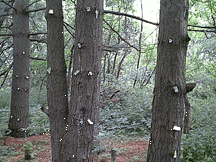
the sun remembers
gathering light from windows
scattering in trees
-----------------------fred bruney
Fred Bruney's temporary installation in the Sculpture Park;
mirrors attached to trees where limbs have fallen off or been removed.
TED STRANDT
Acquiring some boulders from a construction site, I carved bird baths, and bird feeders, in keeping with the natural look of the stone.
DAVID NASH
http://www.sculpture.org.uk/biograph/nash.html
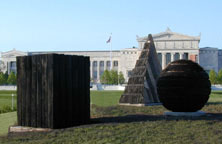
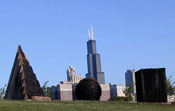
http:// www.ci.chi.il.us/ca/PublicArt/DavidNash.html
RICCARDO SANTOS HERNANDEZ
The commentary is about a turbulent world where nothing is sacred. The new vision is about a world where government and economics play a dominant role over natural phenomena like flowing water, land, and the life that is held within these environments. Agriculture no longer holds the deep cycles of sacred and the sustenance of life it soght to have man live in a balance. The images we hold of this world come from idealized icons of long suffering, hard work, and money, of a superior being where the order of the natural world is altered to fit the needs of man.
BEVERY ELLSTRAND
http://www.caconline.org/cacartists/EllstrandB/ellstrandb.html
Environmental Consequences
A Statement
"We cannot live in this world without being aware of our surroundings.
The man-made cloak of technology is a thin veneer that separates us
from the natural world. As an artist I hope my works serve as a bridge
to communicate my feelings about our interdependent and problematic relationship with nature."
These four paintings are part of an ongoing series that combines art and science. Because of the continuing and growing threat to our environment this body of work helps make statements to the viewer about the ecological threats to our planet through visual imagery. I have used the signs and symbols of the scientist in juxtaposition with the artist's interpretation of nature. The titles are taken from the ubiquitous words that are used in the mass media to describe environmental problems.
In ENVIRONMENTAL FALLOUT, 'plants are shown in diagrammatic fashion. Plants painted in cross-section, their roots exposed, are peppered with brilliant flecks of color that are at once decorative and acidic' (Louise Lincoln, director and curator of the exhibition Apocalypse Now and Then: Art and the End of Time...De Paul University Gallery, Chicago, 1998).
Bright blue FUSION PARTICLES sweep across the painting in a cloud destroying trees, leaves and all earth forms. Botanic diagrams bravely try to sustain life while the earth shines with an eerie glow.
NUCLEAR WINTER refers to the scientific theories regarding the fallout from nuclear accidents or war. In a worse case scenario the earth would be covered with a darkening cloud that would obliterate the sun. In the painting the frost and cold consume the earth as the plants struggle under the ice and snow.
The glowing orange tree in GLOBAL WARNING highlights the threats of pollutants to our earth's fragile ecosystem. Floating cellular diagrams with decaying leaf forms seem to be moving gently through our solar system.
RITA F. PRICE
The technology and processes utilized in printmaking drew me to the medium, and the challenge of making inert metal come alive fascinated me.
As my work evolved, an intense interest in nature developed. Organic shapes and formations seemed to come from some inner source. The basic elements of nature--water, fire, earth were always, in some way, a part of my work.
In the 1980's travel abroad deeply influenced by image making. However, in the last number of years the excitement, immediacy and spontaneity of monotypes took over. I found it a means to creative invention, instinctive reflexes and organic rightness. Between the process of painting on plexiglas and printing the image wonderful transformations occur. This methodology brings me back to painting again, but with a different result. Transferring the painted image from its surface to paper causes a diffuse poetic effect. It can become magical.
CHRIS GAROFALO
Sugared Thornapple/ceramic sculpture
Extinction is a fact of evolution: 99.9% of all species that have ever lived are extinct. The fossil record revealed at the important Burgess Shale of British Columbia triggered a revolution in the way we view the entire history of life on Earth, and particularly, our place in it. Stephen Jay Gould's book, "Wonderful Life" explores the implications of thse discoveries and concludes that we are here by chance. The Earth has endured for well over a billion years while humanity arose just yesterday as a small twig on one branch of the Tree of Life. The diversity of life forms that have existed and the staggeringly improbable series of events leading up to Homo sapiens suggest that contingency ruled, and rewinding and replaying the tape oflife may not necessarily lead us back to us. Life exists neither for us nor because of us, as we have generally been led to believe. As Gould says: "We are a thing, an item of history, not an embodiment of general principals." There have been five previous mass extinctions and scientists agree that we have entered the age of the sixth--this one brought on by humans. Homo sapiens is poised to become the greatest catastrophic agent since a giant asteriod collided with the Earth sixty five million years ago, wiping out half the world's species in a geological instant. * There are microbes living beneath the Earth's crust which would most likely survive despite what happens above ground. If we extinguish ourselves and all other life as we know it, the whole process may begin again with these simple oganisms which resemble those who reigned for nearly two thirds of the entire history of life. This time life may evolve without us and the world will be dominated once again by creatures like those found at the Burgess Shale.
These ceramic sculptures are inspired by life forms we have never known and those, which may yet evolve after the sixth extinction. Neither representational nor recognizable, this work explores the unpredictable, the unrepeatable and the accidental potential of form in an emergent evolution. A public installation of these forms becomes its own ecology--a "playground of contingency"--presenting a subtle reminder of our responsibilities as the single most dominant species on Earth today.
*from The Sixth Extinction: Patterns of Life and the Future of Mankind" by Richard Leaky and Roger Lewin Anchor Books, Doubleday/Bantam Doubleday Dell, 1995.
PHILIPPE BARRIERE STUDIO
While suburbia spreads continuously outward, areas within its expanding limits remain uninhabited due to either too great of an expense or the inability to build on certain terrain. The Trans_pod unit takes advantage of sites where it is either too expensive to inhabit or where traditional building is impossible, thus filling in the voids of urban sprawl rather than contributing to it.
The Trans _pod is a mobile single unit dwelling that is designed to be easily erected in a vast variety of terrain. What is to come of old warehouses and office buildings which are both expensive to renovate and expensive to demolish and redevelop? One of many options of sites for the Trans_pod is to utilize abandoned spaces, much like the Parasite unit, where an old building becomes the host. The building becomes extra protection from the elements while the pod provides a comfortable living environment. The Trans_pod, however, is designed as a self-sufficient structure, in other words, it needs no host. The Trans_pod may be erected on rooftops, in empty lots within cities, on the banks of rivers, in habitable parks, on the side of a mountain, and even in shallow lakes. The pod can be erected anywhere there is access to utilities.
The Trans_pod is designed for a highly nomadic society that migrates on average every nine to ten years, and which includes a great number of people who aspire to own multiple homes in various geographic locations. Instead of owning multiple homes or leaving one home behind to inhabit another, the owner can take their dwelling with them and settle in a great variety of landscapes. Since the owner brings their home with them, hey have an immediate sense of belonging no matter where they settle.
Design Team:
PHASE 01 James_Pfeiffer
PHASE 02 Jeffrey_Windler, Christopher_Staus
PHASE 03 Erik_Heitman
GOSIA KOSCIELAK
I am interested in the archaeology of my time. My concerns focus on two different levels: the macro- and micro-world of man. My subject deals with Prehistory--the border between the geological origin of Earth and the origins of hman civilization; History--the development of contemporary mass culture such as advertising, television, the telephone book of a huge metropolis (condensed information in which a man is just a number); and Man--the main character in history, the border between privacy and global history.
In my paintings, collages and reliefs, I use elements including wooden wheels, stones, earth, small video monitors, cut-up phone books, and holograms. For me they represent our personal search for identity in a multicultural and multimedia world. My compositions are very abstract but the components and details are realistic.
LEE ANN WOOLERY
The simple outline of the infant white dress metaphorically and symbolically represents a universal view of innocence and purity known at birth. It is the symbol of new life, with all of its hopes and dreams yet untarnished. The open weave of the fabric symbolizes the infant's trust in a world yet unknown, representing a place where a child is safe and secure.
Water is synonymous with life. It is the vital ingredient within all life forms. Regular supplies of clean water are the lifeblood of a community. The thick black sludge dripped ceremoniously across the white infant dress speaks of the disrespect and the lack of care of our most precious resources, our children and our water.
ANNE HUGHES
Through layered associations to nature and the environment, evolution, physics and the human spirit, my work reflects a belief in the interconnectedness of all things and the wonder of it all.
DEBORAH KENNEDY
http:// codesign.scu.edu/dkweb/
My installations begin with questions: What are the core values of democracy, and how can we revitalize them? What are the barrieres dividing people, and how can they be bridged? Can technology and the environment exist in balance? Questions addressing social and psychological and environmental themes are the starting points for my installations in galleries and public spaces. These questions matter to me, and my artwork is my small way to contribute to our understanding and response to these social dilemmas.
BETSY DAMON
http://cgee.hamline.edu/rivers/Inquiry/RTT/rtt_bsy1.htm
or
http://artheals.org/artists/Damon_Betsy_38/
Damon first visited China a decade ago as a guest artist at a United Nations conference. She learned about the sacred water site situated in the mountains to the north of Chengdu, which was said to have exceptional health benefits. In 1993 she received a Jerome Foundation travel study grant, which made the trip to this remarkable site in northern Sichuan possible. In 1995, Damon returned to Chengdu, where she directed Keepers of the Waters, the first such public art event in China. This two-month project, which included more than 15 performances and the creation of public exhibits and sculptures, was designed to build awareness about water contamination in the Fu and Ilan Rivers. A vehicle for establishing relationships with experts and community members. Keepers of the Waters, attracted media coverage througout China. An invitation to build the Living Water Garden, a 5.9 acre public environmental park that commingles education, water treatment, water awareness, recreation, and aesthetics, grew out of Damon's previous project in China. The park, which officially opened in the fall of 1998, demonstrates that nature has the power to clean water and that artists are a conduit through which new means to sustain our fragile ecologies can flow.
CAROLYN OTTMERS
http:// www.artic.edu/saic/art/projects/faculty/cottmers-p1.html
Ground Cover
My sculptures are often a hybrid of forms, processes, and materials derived from the urban and natural landscape. It is my desire to blur the distinctions between the two environments to suggest their semblance. Inspired by nature, the forms are primarily generated through the casting process in a variety of industrial materials: ironm, aluminum, glass, rubber, paper, wax, concrete, etc. For me, the associative nature of a given material as well as its aesthetic qualities, play an important role in defining the content of nature of my sculpture. My work often involves multiples, reflecting on interest in the variation and diversity of nature and the production of objects for consumption.
If you look closely, you will notice "Ground Cover" is comprised of over 500 leaf shaped objects made out of glass. If you look closer, you will notice slumped shards made out of glass and distorted labels from various drinks, such as Corona, Dr. Pepper, Rolling Rock, Coca-Cola, and Absolut Vodka. To make this piece, I collected all the beer, wine, and soda pop bottles discarded in the vacant lot across the street from my residence in Chicago. Each bottle was smashed into shards and layered into plaster molds. Each mold was placed into a kiln and heated until the glass melted and fused together to form a leaf. "Ground Cover" examines how cycles from nature are echoed in the urban environment.
I work mainly in public art/environmental projects, functional earthworks and sculptures, the redesign of landill site-in both urban and rural landscapes. Indoors and outdoors, permanent, temporary, large and small scale, my sculpture is site specific in that it relates to the sites, considering the history, economy, landscape or -wood, stone, earth, planting, bricks, steel, cement, bronze, water, glass, plastics, light, etc.
MARY JANE DUFFY
http: //www.depaul.edu/~mduffy1/studio/index.html
Broken Symmetries
My recent work addresses certain environmental issues that have concerned me for some time. Man's impact on the natural world is profound. Specific issues I deal with are human overpopulation, pollution and invasions of non-native species in ecosystems. While these ideas are key to a deeper understanding of the pieces, I still rely on the beauty of painting and drawing to draw the viewer into the work.
Formally the work creates a conflict between two different orders: the order of a flat, two-dimensional pattern and the order of perspective. Patterns are taken from natural forms-leaves, fish, insects, pollen, etc. At some point in each piece, the pattern is disrupted by a reference to the three-dimensional world. This reference to space takes the form of shapes that imply perspective, as we would see it in the landscape. Patterns are painted completely flat, denying the illusion set up by larger forms. IN this way, my paintings explore dichotomies: male vs. female, and illusion vs. flatness, man vs. nature. The painting of illusionistic space, associated with western, masculine tradition, utilizes perspective devices such as overlapping, diminishing size and linear perspective in order to create an illusion of the three-dimensional world on a two-dimensional surface. This tradition is entirely different from the decorative arts, which has been associated with women. Quilting, weaving, and needlework use repetition of flat, simple, brightly colored forms to create a pattern. In my work, pattern does not follow the shapes that imply perspective; rather they reinforce and echo the edges of the canvas, reminding one of modernism and its celebration of the materiality of painting-physicality of paint, brushmark, the square or rectangular form of the canvas and flatness of the painted surface.
"EARTH WORKS" was sponsored in part by the Illinois Arts Council